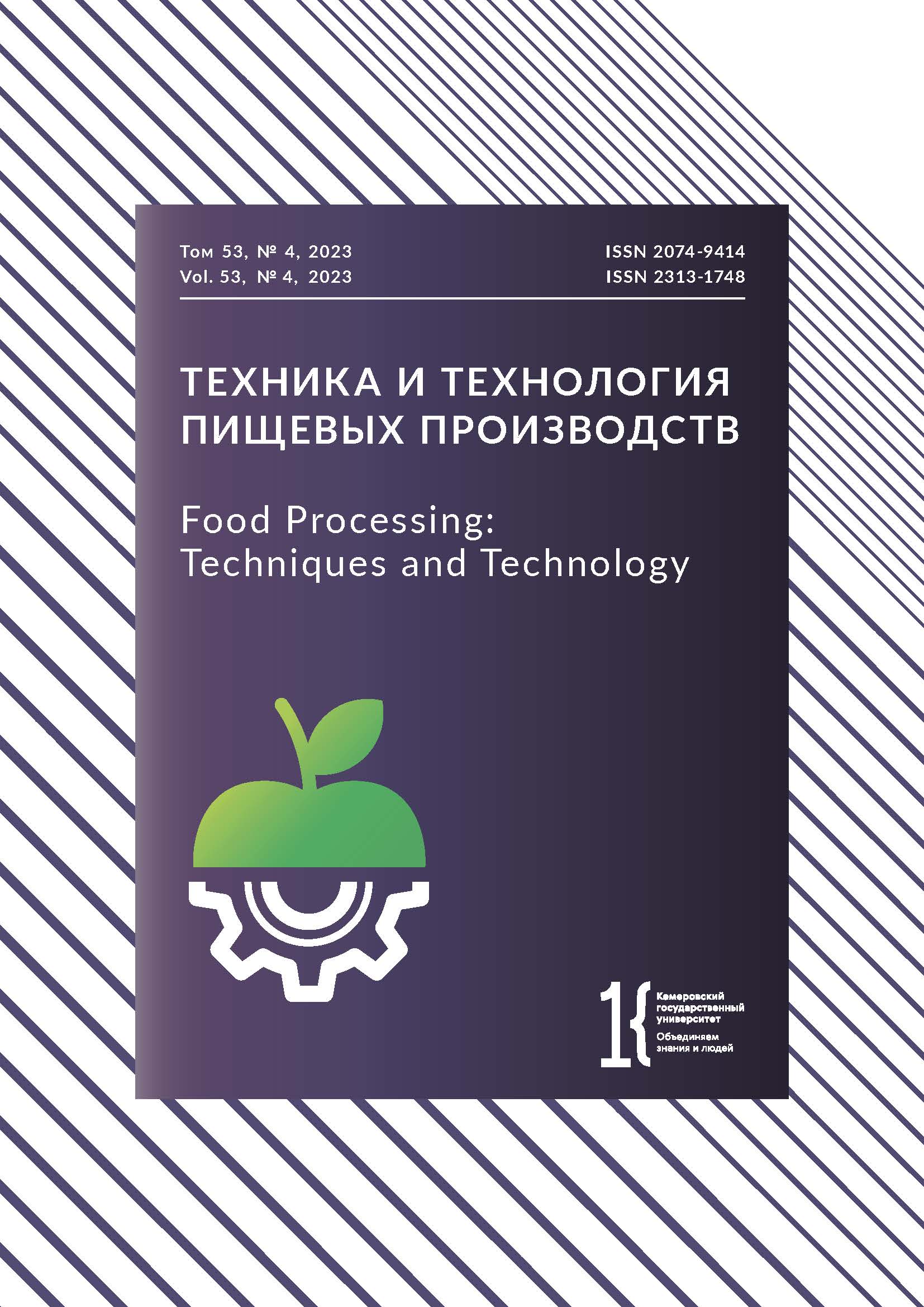Vidnoe, Moscow, Russian Federation
Vidnoe, Moscow, Russian Federation
Vidnoe, Moscow, Russian Federation
Vidnoe, Russian Federation
Vidnoe, Russian Federation
The slowest heating zone tends to move about in food systems with convective and predominantly convective heat transfer. If the thermocouple follows the movement, the process lethality differs from the value precalculated for a fixed thermocouple location. Hence, the heat treatment modes depend on the movement of the slowest heating zone, which should be taken into account before planning food system processes. This research aimed at identifying a statistically significant difference between lethality for fixed and moving slowest heating zones in various food systems. The study involved four homophasic and heterophasic model food systems. Food System 1 was heterophase, with a dispersed phase not involved in convection and a liquid dispersion medium of aqueous solution with 1.5% sucrose and 1.5% NaCl. Food System 2 was heterophase, with a dispersed phase not involved in convection and a liquid dispersion medium of 11% aqueous sucrose solution. Food System 3 was represented by homophase reconstituted clarified baby-food apple juice with 11.2% soluble solids. Food System 4 was a heterophase model system, represented by reconstituted baby-food apple juice with pulp and 11.2% soluble solids with a dispersed phase involved in convection. The temperature changes were monitored using the E-ValPro multichannel system and the SSA-TS model temperature sensors. The temperature sensors were fixed inside the jar with the food system. Food System 1 showed no significant differences in lethality. Other model systems had sterilization temperature intervals when the difference in lethality was statistically significant. However, this difference was very small for Food Systems 2 and 3. The largest difference belonged to Food System 4, where the dispersed phase was involved in the convective flow. In this research, a statistically significant difference in lethality for fixed and moving slowest heating zones occurred only in heterophase food systems with convective and predominantly convective heat exchange, where the dispersed phase was involved in the convection flow. This fact must be taken into account when identifying heat treatment modes for such food systems.
Zone, heating, kinetics, lethality, thermophysical processes, modes, heat treatment
1. Park HW, Yoon WB. Computational Fluid Dynamics (CFD) modelling and application for sterilization of foods: A review. Processes. 2018;6(6). https://doi.org/10.3390/pr6060062
2. Borah R, Gupta S, Mishra L, Chhabra RP. Heating of liquid foods in cans: Effects of can geometry, orientation, and food rheology. Journal of Food Process Engineering. 2020;7(43). https://doi.org/10.1111/jfpe.13420
3. Jahanbakhshian N, Hamdami N. Numerical simulation of heat and mass transfer during heating and cooling parts of canned-green-olive pasteurization. Journal of Food Process Engineering. 2021;44(12). https://doi.org/10.1111/jfpe.13909
4. Ranjbar N. Numerical calculation F-value and lethality of non-newtonian food fluid during sterilization based on can geometry. Iranian Food Science and Technology Research Journal. 2019;14(6):113-125. https://doi.org/10.22067/ifstrj.v0i0.71219
5. Mohamed IO. Modeling and simulation of thermal sterilization of conduction heat canned foods using heat transfer coefficients boundary conditions. International Journal of Food Processing and Technology. 2016;3(2):48-53. https://doi.org/10.15379/2408-9826.2016.03.02.03
6. Lee MG, Yoon WB. Developing an effective method to determine the deviation of F value upon the location of a still can during convection heating using CFD and subzones. Journal of Food Process Engineering. 2014;37(5):493-505. https://doi.org/10.1111/jfpe.12107
7. Stolyanov A, Zhuk A, Kaychenov A, Kuranova L. Comparative analysis of temperature loggers used in the development of regimes for heat treatment of food production in autoclaves. IOP Conference Series: Earth and Environmental Science. 2019;302. https://10.1088/1755-1315/302/1/012031
8. Montanari A, Barone C, Barone M, Santangelo A. Thermal treatments of canned foods. Analytical and Bioanalytical Chemistry. 2018;410:5099-5100. https://doi.org/10.1007/s00216-018-1158-8
9. Montanari A, Barone C, Barone M, Santangelo A. Canned foods: Principles of thermal processing. In: Montanari A, Barone C, Barone M, Santangelo A, editors. Thermal treatments of canned foods. Cham: Springer; 2018. pp. 1-15. https://doi.org/10.1007/978-3-319-74132-1_1
10. Ziogou C, Kostoglou M, Georgiadisac MC. Nonlinear model predictive control of food sterilization processes. Computer Aided Chemical Engineering. 2021;50:1155-1160. https://doi.org/10.1016/B978-0-323-88506-5.50178-9
11. Zhuk A, Stolyanov A, Kaychenov A, Kuranova A, Grokhovsky V. Software for calculating the actual lethality of canned food heat treatment processes: Development and application. E3S Web of Conferences. 2021;273. https://doi.org/10.1051/e3sconf/202127313002
12. Krylova VB, Gustova TV, Bataeva DS, Gorbunov VN. On the question of using melting indicators for controlling sterilization temperature parameters. Vsyo o Myase. 2021;(2):52-54. (In Russ.). https://doi.org/10.21323/2071-2499-2021-2-52-54
13. Tucker G, Featherstone S. Essentials of thermal processing. Ames: Wiley-Blackwell; 2011. 264 p.
14. Skoglund T. On the common misuse of a constant z-value for calculations of thermal inactivation of microorganisms. Journal of Food Engineering. 2022;314. https://doi.org/10.1016/j.jfoodeng.2021.110766
15. Jafarpour D, Hashemi SMB. Ohmic heating application in food processing: Recent achievements and perspectives. Foods and Raw Materials. 2022;10(2):216-226. https://doi.org/10.21603/2308-4057-2022-2-531
16. Riazantseva KA, Sherstneva NE. Traditional and innovative uses of ultraviolet treatment in the dairy industry. Food Processing: Techniques and Technology. 2022;52(2):390-406. (In Russ.). https://doi.org/10.21603/2074-9414-2022-2-2372
17. Stier R. Swainson's handbook of technical and quality management for the food manufacturing sector. Woodhead Publishing; 2019. 606 p.
18. Friso D. A new mathematical model for food thermal process prediction. Modelling and Simulation in Engineering. 2013;2013. https://doi.org/10.1155/2013/569473
19. Serami MS, Ramezan Y, Khashehchi M. CFD simulation and experimental validation of in-container thermal processing in Fesenjan stew. Food Science and Nutrition. 2020;9(2):1079-1087. https://doi.org/10.1002/fsn3.2083
20. Erdoğdu F, Uyar R, Palazoğlu TK. Experimental comparison of natural convection and conduction heat transfer. Journal of Food Process Engineering. 2010;33(1):85-100. https://doi.org/10.1111/j.1745-4530.2008.00309.x
21. Rinaldi M, Malavasi M, Cordioli M, Barbanti D. Investigation of influence of container geometry and starch concentration on thermal treated in-package food models by means of Computational Fluid Dynamics (CFD). Food and Bioproducts Processing. 2018;108:1-11. https://doi.org/10.1016/j.fbp.2017.12.003
22. Zhu X, Zhou Q. Flow structures of turbulent Rayleigh-Bénard convection in annular cells with aspect ratio one and larger. Acta Mechanica Sinica. 2021;37(8):1291-1298. https://doi.org/10.1007/s10409-021-01104-z
23. Kondratenko VV, Kanevsky BL, Pokudina GP, Senkevich VI, Borchenkova LA. Slowest heating zone migration for heterophase model food system when sterilized. Bulletin of KSAU. 2021;176(11):188-197. (In Russ.). https://doi.org/10.36718/1819-4036-2021-11-188-197











